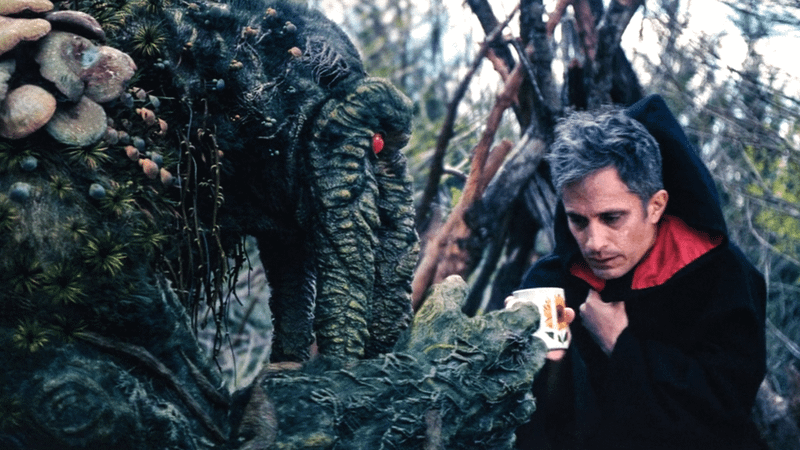
Werewolf By Night's first trailer surprised everyone when it premiered in black and white. Marvel producer Brian Gay explained there’s a stylization on using this color palette since it pays "homage to these classic monster movies, but it just feels new within the MCU."
In addition, Werewolf By Night director Michael Giacchino also revealed that he “had always assumed” the ratings would land on TV-MA due to its blood and gore, but he acknowledged that "the black and white did help keep us within a certain range.”
True enough, the combined use of black and white and the impressive portrayals of monsters on-screen resulted in positive reception from fans and critics, making the project stand out from the rest of the MCU entries.
Now, as the project is currently enjoying its Disney+ premiere, Giacchino opened up about an unexpected shift in its ending.
Werewolf by Night Director Expands on Ending
Warning - The rest of this article contains spoilers for Werewolf By Night.
After mostly being colored in black and white, Werewolf by Night's ending showed everything turning into color once Elsa gains possession of the Bloodstone.

During a Q&A at this year's Fantastic Fest, Werewolf by Night director Michael Giacchino explained the reasoning behind the color shift towards the end of the special, noting that it "represents a change in the dynamic of their world."
The veteran composer then pointed out that Laura Donnelly's Elsa is "now in charge," and "it felt like she is bringing a light" into the world:
“Because that, to me, represents a change in the dynamic of their world, you know? Like Elsa is now in charge and it felt like she is bringing a light to the world that didn’t exist there before."
Giacchino then explained the lesson that Elsa learned throughout this special, mentioning that "everything has layers and depth:"
"Prior to that, her father had run things with an iron fist and he was the kind of guy that was like, ‘Okay, you’re a monster? You should be dead.’ And there was no in-between." And I think the lesson for Elsa was the lessons we all hope to learn, we hope the world learns, is that not everyone is one thing. You know, everything has layers and depth. And humanity deserves empathy. So you know, that to me was saying, ‘You know what, it’s a whole new world now. And let’s see what happens after this.‘”
The Werewolf's "totally modern" design in the special was also pointed out in the Q&A, noting to Giacchino that he decided to keep the character's human features.

Responding to the comment, the Marvel director shared that keeping the human qualities of the titular werewolf was "very important" to him:
“Yeah, one of the things I loved about films like [An American] Werewolf in London is that you can actually see the actor’s face and you could see the eyes. It wasn’t buried beneath a bunch of stuff where… it didn’t turn into just a wolf. You know, it still kept the human qualities. I think that was very important, especially to me, to say, ‘You know what, behind this thing we call a monster is a person. Is a person with feelings and somebody who’s dealing with an issue that is very tough to deal with.’"
Giacchino continued to reiterate that none of the characters want to be monsters, insisting that they are just "people who need help:"
"None of these monsters want to be monsters. None of them want that. And these are all, basically if you look at them, people who need help. And I feel like that’s what they are and the world is always against them. So you can only imagine what that must be like to be in a situation where the world looks at you as a monster but you, yourself, know you’re not.”
Interestingly, this isn't the first time in the MCU that a black-and-white color palette transitioned to a color-friendly environment. At the tail-end of WandaVision Episode 2, the titular heroes can be seen reacting to their background changing from black-and-white to a colorful one.

Why the Color Change Works for Werewolf By Night
Many would agree that the shift in color at the end of Werewolf By Night was unexpected, mainly because a good chunk of viewers believed that the project would remain purely in black and white. Michael Giacchino's latest comments proved that this change was an effective transition, especially after it mirrors Elsa's takeover of the Bloodstone manor.
It also signifies the end of the reign of terror of the Bloodstone lineage toward the monsters, indicating that Elsa serves as the beacon of change that will improve the ties between the humans and these creatures.
Moreover, the addition of color to Werewolf By Night's ending could also hint that the next project involving Jack Russell, Man-Thing, and Elsa Bloodstone will retain this element, moving away from the black-and-white color palette. Still, the question remains if this change would pave the way for the special to explore a more mature rating in the future, considering the monotone visuals allowed for more gruesome effects for this project.
Werewolf By Night is now streaming on Disney+.












